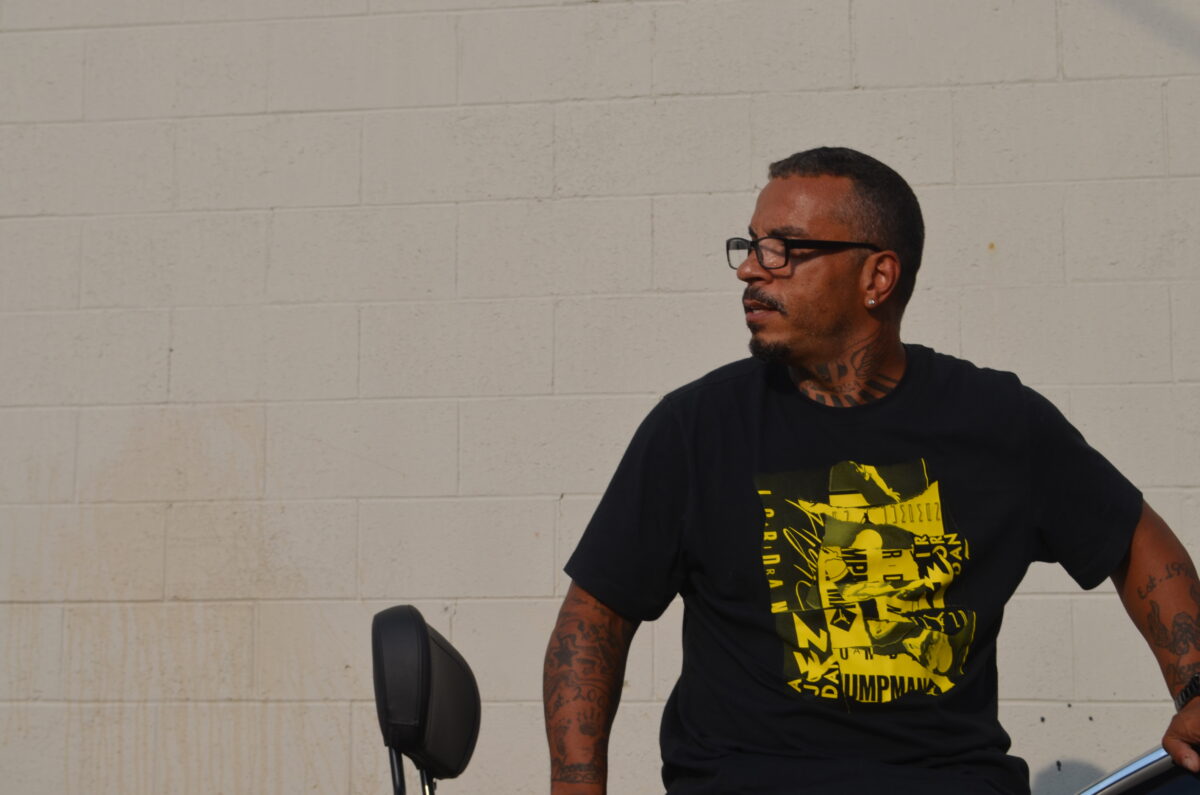Mike Young resumes painting a mural he’s been working on for the last eight weeks. He has just returned from a daily probation program to the Salvation Army Shelter on E. Main Street in Newark, where he lives.

The bright colors in the mural on a wall in the Salvation Army dining room portray one positive image after another. Young carefully outlines the final letters of the word “good.”
For Young, 46, the past few months have brought him stability that he hopes will set him on a path to success and away from the one that repeatedly led him to trouble.
“When it’s all said and done, it comes down to structure; structure is all that matters,” he said.
The structure that Young needed in his life is the probation program that has kept him out of trouble – and jail – for the past three months.
In early April, Young was arrested on several charges, including drug possession, which exacerbated his ability to find and afford housing. Even as development booms and jobs pour into Licking County, Young is among the rising number of people in Licking County who struggle to find housing due to substance use disorder, prolonged poverty cycles and the tight housing market.
Young has lived all three. And even with his efforts to stay sober and out of trouble, he still might not be able to afford a home in a county where rental prices have gone up 25% in the past couple of years.
He was held in the Licking County Jail for three weeks in April before he could pay his $3,000 bond for release pending trial. His future appeared grim. Young was facing the possibility of spending the next eight years in prison, but then hope arrived in the form of Young’s pre-trial parole officer, Brandy Nelson.
Nelson told Young about a “day-reporting program” offered through the Licking County Adult Court Services. This would provide Young the opportunity to address some of the issues he’d been dealing with his whole life and, hopefully, demonstrate personal growth to the court on judgment day.
Young’s attorney asked the court for a continuance of Young’s July hearing date to give him a chance to participate in the program that would help him deal with the trauma and addiction that affected him deeply. His new date will be at the end of August.

“At first, the reason I was doing this was to avoid getting locked up again, but now, the truth is that I’m doing this for me, my family and for my future self,” Young said.
This outlook would’ve seemed foreign to Young 20 years ago.
“Since the age of 15, I’ve lived like an adult; I never really had that gradual transition other kids have,” Young said. “It felt like one day, I was a kid going to the park, then the next, I was running from the police at 13.”
Young grew up in the Washington Square apartments on Eastern Avenue with his mom, stepdad and four siblings.
“My childhood was very unstable. Everything from domestic violence to cops to constantly moving around – even had a few stints in foster care somewhere in there,” Young said.
Young said that his family’s financial situation left him looking for ways to make ends meet on his own. Realizing this at an age when working a real job wasn’t a possibility, Young took to an alternative form of money-making.
That included theft, flipping stolen items, and in some cases, helping others deal drugs.
“From a young age, I’ve been deeply embedded in the streets,” he said.
The lifestyle and mentality that Young learned growing up didn’t leave him when he turned 18. Just a few months into adulthood, Young found himself in prison for the first time, on an unauthorized use of a motor vehicle charge.
“The first time locked up is foreign,” he said. “It’s like going to a different school and navigating the lunch room. After a while, though, that initial feeling of uncertainty wears off and it becomes normal.”
Young’s first time wouldn’t be his last.
“I’ve spent almost 10 and half years of my life behind bars,” Young said.
He says he became complacent with his life in and out of prison.
“When life in prison becomes routine – like it did for me and many like me – I felt as though change can’t happen, like those locking you up want it to. I’ve grown more as a member of society in the past three months in this day-reporting program than I had in over a decade in prison.”
Back in April, after bonding out of jail, Young enrolled in the day-reporting program in hopes of changing his ways. He knew that if he didn’t change, history would likely repeat itself.
The Licking County Adult Court Services Day Reporting Program provides offenders with a restorative alternative to incarceration. In the program, participants enjoy drug and alcohol counseling, mental health services and professional/job placement assistance.
“This program isn’t foolproof,” program Director Michele Hamann said. “What I mean by that is, you can’t force someone to change. They have to genuinely want change. Everyone’s different, everyone’s got their own timeline. The best we can do is be by their side with support.”
– – – – – –
Poverty and housing insecurity in Licking County are on the rise. The average cost of rentals in Licking County has increased by 25% in the past two to three years. And a report by the United Way of Licking County shows that 10% of Licking County residents live in poverty and approximately 27% live one paycheck away from losing their homes. In that same report, the United Way said that a “household survival budget,” which represents the minimum cost of living here for a four-person household is $69,516 per year. And yet, in 2021, 3,041 families in Licking County lived in poverty, according to the 2023 Ohio State of Poverty Report.
Sources: United Way of Licking County reports, Licking County Coalition for Housing studies and the Ohio Association of Community Action Agencies.
– – – – – –
Margin for error
Mike Young had used drugs the majority of his adult life: heroin, meth, cocaine – the full menu.
Like a lot of people who use illicit drugs, Mike saw the supply shift from pills to heroin to fentanyl.
“Ten years ago, it was all heroin, and now fetty [fentanyl]. That’s not the shift you wanna see,” Young said.
A 2023 report by Harm Reduction Ohio says that during the past decade, Ohio’s illicit drug supply has become increasingly more dangerous, primarily because fentanyl has replaced heroin as the primary opioid.
“It really is concerning,” said Ben Shirley, outreach specialist for Behavioral Healthcare Partners of Central Ohio in Newark. “The margin for error was slim with heroin; there is no margin with fentanyl … just the smallest amount too much, and that’s it.”
According to a Drug Enforcement Agency intelligence report released in 2022, the flow of fentanyl through the U.S. is now far heavier than a decade ago.
The same report noted that the trend of heroin overdose deaths in the U.S. was decreasing, while the overdose deaths from fentanyl was increasing.
The trends in Licking County mirror the national trends. Annual reports examining drug overdoses from the Licking County Coroner’s office illustrate the increase in fentanyl-related deaths in the past six years.
Between 2017 and 2022, 61% of all drug overdose deaths in Licking County were attributed to fentanyl alone, or other narcotics that contained fentanyl. Last year, 40 of the 58 overdose deaths involved fentanyl.
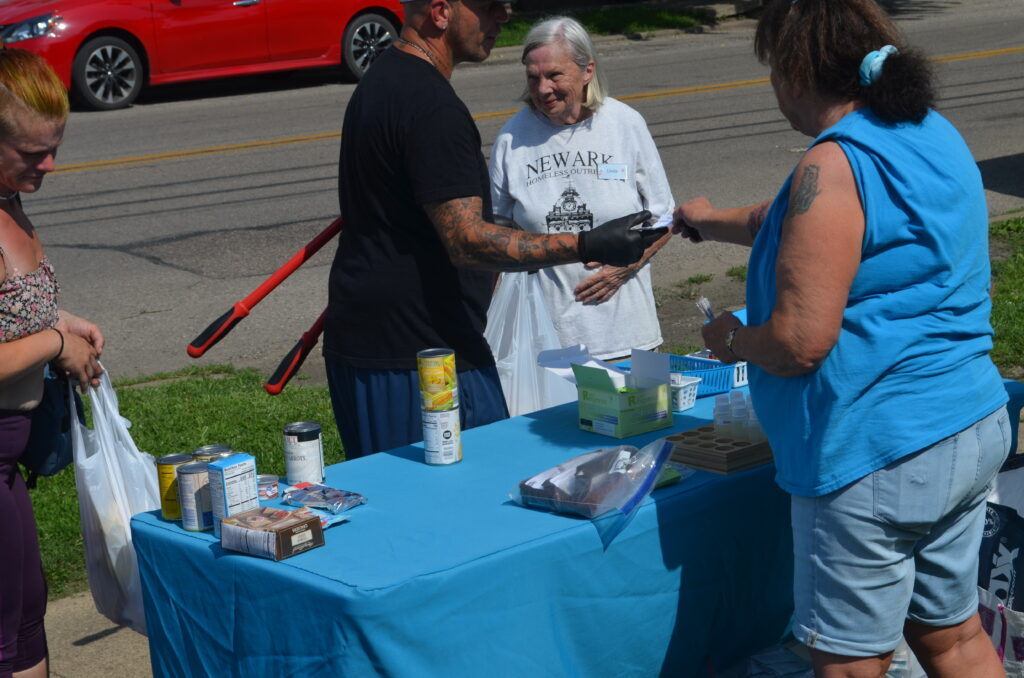
“These stunning numbers just account for those who are dying from overdosing,” said Trish Perry, co-founder of the Newark Homeless Outreach.
Young said that, “When you’re addicted to fentanyl, most people would rather die of an overdose than face the dope sickness that comes when you’re deprived of the drug in rehab.”
When someone is “dope sick” (suffering from withdrawal from opioids), they can experience a range of symptoms, including intense cravings for opioids, muscle aches, nausea, vomiting, diarrhea, excessive perspiration, anxiety, restlessness, insomnia, and overall flu-like symptoms.
Typically, these more intense physical symptoms persist until the drug has exited the person’s system, which can be up to five days.
For Young, this happened in October of 2022, when he said he checked into Hope Valley Recovery in Circleville for a 45-day detox treatment and recovery.
“The hardest part of recovery for me was that first week,” Young said. “The staff is there to support you, but for all that physical sickness, you have to go through it on your own.”
Once the fentanyl had left Young’s system, he was put on the opioid prescription drug Suboxone, which reduces withdrawal symptoms and the cravings for stronger opioids. For Young’s recovery, the medication would act as an intermediary treatment before moving to monthly shots of Vitriol.
Vivitrol is a long-acting formulation of naltrexone, which works to block the effects of opioids in the brain. Medication-assisted treatment helps some people sustain recovery and allows them to live their lives. Medicaid paid for the shots.
With a Vivitrol dog tag around his neck, Young explained the power of the medication.
“It’s life-changing,” he said. “It completely takes away your body’s obsession with having the drugs in your system. I’m super grateful to have been put on it, and think it has the potential to help a lot of the people out here.”
While sitting on benches in the shade of a towering tree on the Salvation Army’s lawn fronting E. Main Street, Young glanced down at his phone, looking at a “virtual sobriety chip” that displayed the number 97 – the number of days without drugs.
“I haven’t been sober this long in over 30 years – since I was 15,” he said. “Time being sober is power for me. Everyday, I feel stronger, more like the person I’m supposed to be.”
That accumulated time empowered Young recently when he found himself around some people who were using drugs.
“Wasn’t even a question to say no to them,” he said, nodding his head. “I’ve got so many people rooting for me, caring about me, loving me now. I can’t let them down, and I can’t let myself down like that.”
– – – – – –
Overdose deaths are on the rise in Licking County. During the past six years, 256 people in the county have died because of an overdose. In 2022, 49 of the 58 overdose deaths were caused by an opioid, primarily fentanyl. Fentanyl is a synthetic opioid that is up to 50 times more powerful than heroin and 100 times more powerful than morphine. The drug is an important medicine often prescribed by trained medical professionals as a painkiller, but illicit forms of the drug are sold on the streets.
Sources: Licking County Coroners Office (via Patricia Perry), Centers for Disease Control and Prevention (CDC).
– – – – – –
Keeping guard
Mike rarely lived outdoors, but he rarely had a place to call his own. He mostly couch-surfed or squatted. It was safer than being in a camp, exposed to the elements and other dangers.
One night in early April, Mike was arrested with more than an ounce of meth, which Newark police found. He soon was in the back of a cruiser on the way to jail.
While Young was arrested on a drug-related offense, much of the Newark Police Department’s interaction with unhoused and unsheltered residents does not revolve around drugs, said Officers Michael Lake and Justin Wisecarver while on patrol in late June.
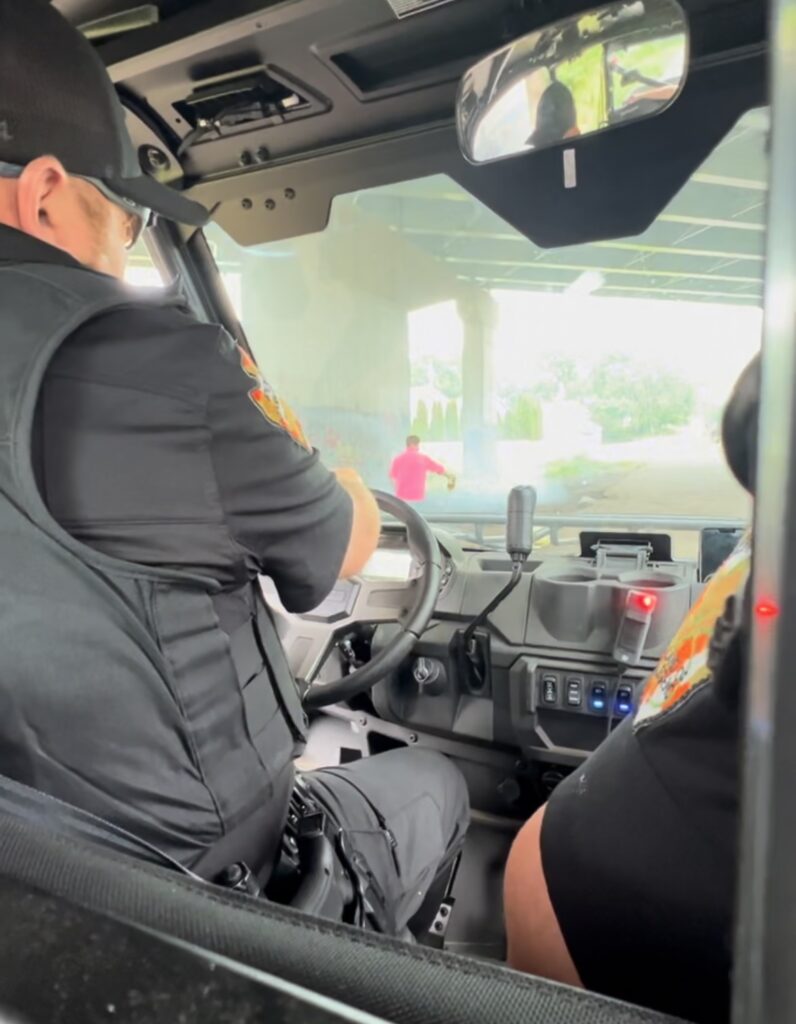
The officers drove a police department side-by-side ATV east along the main train railroad tracks that run east and west through Newark, and they talked about camps built by unhoused people in that area of the east end.
“Seems to be a popular spot because, for the most part, they’re out of the public eye but also close to downtown and the resources there, like the Salvation Army,” Wisecarver said.
The Newark Police Department interacts with the unhoused population regularly, whether it’s de-escalating an occasional domestic dispute or moving people who camp on private property when the owners file a complaint about trespassers.
Such encampments have been showing up more frequently in recent years on private property, such as land owned by the railroad, police said.
Lake said the last three years have been challenging. The year “2021 was particularly busy,” he said. “I remember that summer, we received a lot of complaints and had to move a fair deal of camps.”
Wisecarver explained how the department monitors issues related to the unhoused residents of Newark: “By no means are we out here patrolling with the intention of pinning anyone or taking down encampments,” he said. “With these types of things, it’s almost all the time complaint-driven.”
But not always. While on patrol that day in June, Lake and Wisecarver came across a small campfire under a Rt. 79 bridge over the railroad tracks.
The fire was fueled by cardboard and twigs. Most concerning to the officers, though, was that it had been left unattended – or so it appeared. From up under the bridge, at the top of the abutment, walked a man with more twigs under his arm.
“How’s it going, sir?” asked Lake. “Hate to do this to you, but you’re going to have to put out this fire.”
The man, who wore a pink, button-down shirt and sweatpants, mumbled a response under his breath and picked up an old two-liter soda bottle filled with a yellow liquid and poured it over the flames.
Lake asked for the man’s personal information and followed the protocol, calling in Newark Fire Marshal Tim Smith.
While awaiting Smith’s arrival, the officers chatted with the unhoused man, talking about everything from the four-wheeler the officers were driving to where the man had lived before his life without a permanent home.
Smith arrived and continued the conversation with the same energy, a combination of lightheartedness and professionalism. As this was the unhoused man’s first offense of what was technically considered arson, Smith left him with a warning while also informing him where in Newark campfires are allowed and considered safe.
In all, the interaction between the authorities and the man lasted about 20 minutes. Lake and Wiscarver said such a smooth interaction is uncommon.
“Usually, we’re not dealing with small campfires like the one back there,” Wisecarver said. “A lot of our calls are related to domestic violence, drugs, disturbances.”
The officers said the challenge in defusing such situations is that they often are fueled by emotion and sometimes by alcohol or drugs.
“We’re thrown into a hard situation that many of us, realistically, aren’t fit to deal with,” Lake said, referring to the limited social-work training that Ohio police academies provide during basic training.
Wisecarver recalled spending one to two hours in the academy learning how to effectively deal with domestic violence and related situations. Both officers agreed that while social work isn’t technically part of their responsibilities, they encounter many situations that require those skills.
“There’s a lot we could talk about when it comes to police relations with the homeless,” Wisecarver said. “But I think it boils down to making sure members of our department are educated and equipped to deal with overly intense situations that a normal person just wouldn’t be able to handle.”
– – – – – –
The numbers of unhoused and unsheltered people continue to rise in Licking County. In 2019, the number of unsheltered individuals was 45 adults. In July 2023, that number had risen to 100 unsheltered adults. A point in time report released by the Licking County Coalition forHousing, in July showed that 18 families in Licking County were experiencing homelessness, and that 91% of the homeless people in Licking County at the time were homeless for the first time. The average household in Licking County is two paychecks away from becoming homeless. And there are no low-barrier shelters in Licking County to take in people with pets or struggling with addiction, only the occasional warming center during the coldest days of winter.
Sources: Licking County Coalition forHousing Point-in-time Count and housing data, United Way ALICE Report.
– – – – – –
Food and shelter at The Salvation Army
Not far from the railroad tracks, nearly 80 hungry residents of Newark file into The Salvation Army for dinner on a hot, humid summer day.
An hour prior to the 5:30 p.m. serving time, many dinner guests had been waiting on the circle of benches under the large oak tree in front of the building.
As guests enter, tri-sectioned trays are filled with sloppy joes, peas and fruit salad. Orange Kool-aid and lemonade await at the end of the counter, and the drinks prove to be popular on this hot July day.
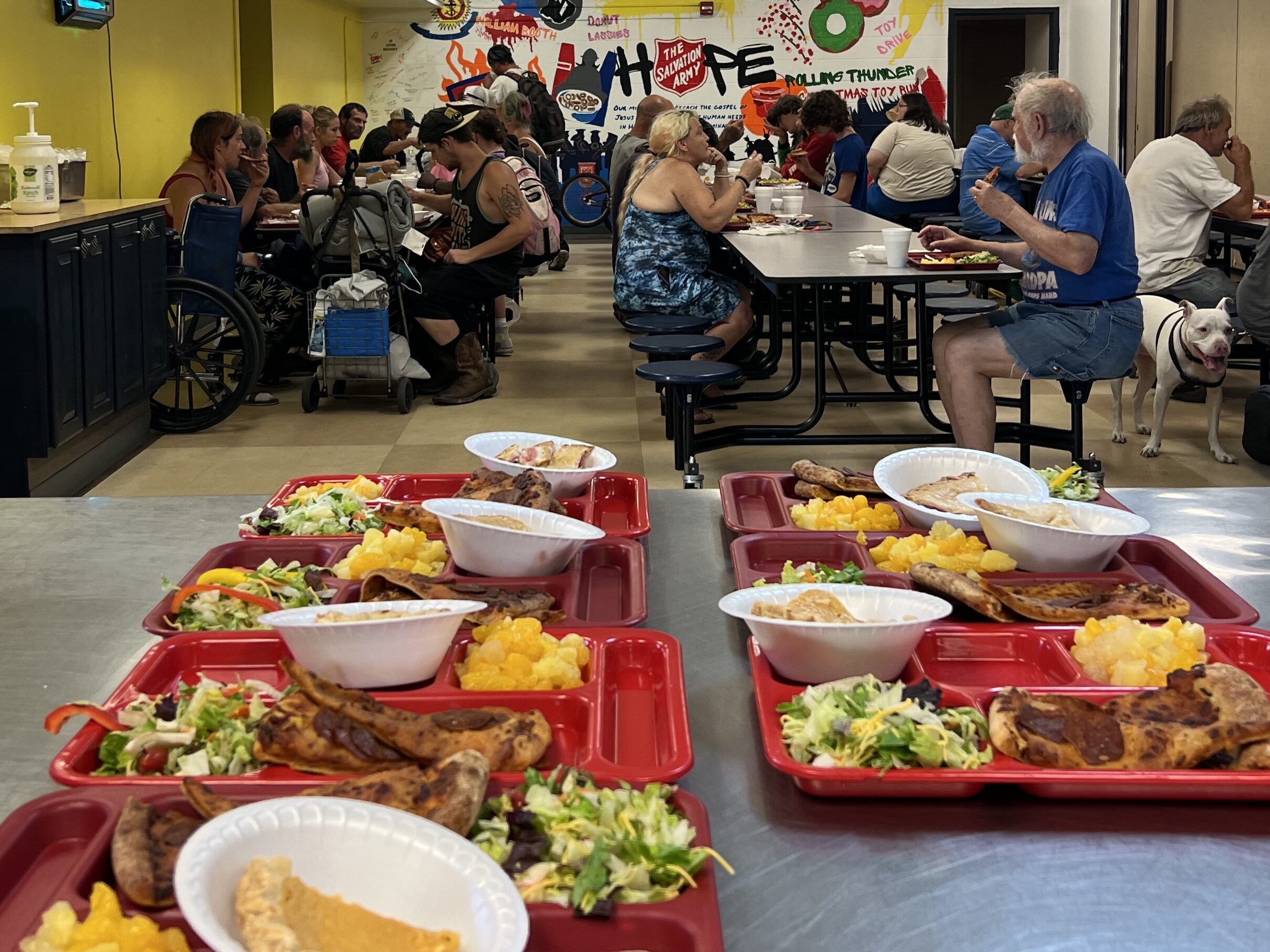
Serving the dinner guests from across the counter are volunteers and residents of the Salvation Army Shelter. These residents have a rotation of mandatory chores, one of which is assisting with serving meals.
On this night, Young is working on the line, loading trays with generous helpings of everything. He’s been on the other side of the counter, and understands their situation.
Dinner guests sit at one of the three tables that stretch 25 feet across the room. Many take a seat with familiar faces.
“You got your crew, and you sit with your people,” said one unsheltered guest at the place they affectionately call “The Sally.”
The Salvation Army serves three meals every day. It had been lunch and dinner until 2019, when it added breakfast. Typically, dinner is the most attended meal, when it serves an average of between 100 and 170 guests a day.
This summer, the Newark Salvation Army also organized and ran the Summer Food Service Program, which provided meals to any child under the age of 18 without charge. From June 12 through July 21, Monday through Friday, children could pick up free brown bag lunches at nine locations in the city.
“We find that children often go unrecognized within family financial insecurities, so this is our way of recognizing them and their very important need for nutrition,” said Salvation Army Social Services Secretary Jeanne Ferrara.
Ferrara said that the program drew an average of 290 children daily for lunch.
The Salvation Army in Newark also is home to a 50-bed shelter with separate wings for men and women, and a wing for families. It provides them with a bed and clean shower, and a host of services.
The shelter is not a low-barrier shelter, meaning that residents must pass a background check before checking in. An individual seeking shelter must have no recorded violent offenses within the past year. Additionally, residents are prohibited from using drugs and alcohol on the property, they cannot bring pets or weapons into the facility, and they must agree to engage in chores around the building.
When a client checks into the facility, the person is assigned a case manager who works with that person to develop a plan to help solve whatever crisis the person might be facing. This typically manifests in a flexible, 90-day program.
Timothy Higgins, Major of Salvation Army in Newark, said that the goal of the program is for clients to improve their housing and employment situation, ultimately becoming self-sufficient.
“Everyone of our clients is different, and therefore requires a unique plan that works specifically for them,” he said.
Young checked into the men’s wing of the shelter in May of 2023.
Since moving there, his schedule has reached a heightened level of structure. Every weekday, he’s out of the shelter by 8 a.m., he spends the next seven hours at the day-reporting program, and then returns to the shelter, where he helps with tasks such as painting the large mural in the dining room.
“Can’t remember the last time in my life I was consistently waking up at seven in the morning and going to sleep at 10 at night, but honestly, that’s what it takes for someone like me to really change,” Young said.
Young added how much the staff at the Salvation Army has assisted in his growth.
“There’s many people here that I am eternally grateful for – Major Connie Higgins, Jennifer Dalton, Lyndsay Ross and the rest of the staff at the Salvation Army,” Young said.
After the dinner rush had slowed on this July 3 evening, Young grabbed a portable speaker from the back of the kitchen and walked to a table in the middle of the dining room and sat down.
Moments later, “A Change Is Gonna Come,” by Sam Cooke, filled the room, creating a cool breeze of hope on a sweltering summer day.
By accident or choice, Young’s music carried the message that change is possible and that a dinner eaten in the comfort of a permanent home is an achievable reality.
“If there ever comes a day when I drive past this lawn and see all these people out here and forget what it was like to feel what they’re feeling, I’ll be a sad, sad man,” Young said, with the words of Sam Cooke still in his ears.
“It’s been a long,
A long time coming, but I know
A change gon’ come,
Oh yes, it will.”
– – – – – –
Where to find help: If you or someone you know is dealing with poverty, lack of housing, mental health issues or substance abuse disorder, here are some places in Licking County to seek help:
– Pathways of Central Ohio, 1627 Bryn Mawr Drive, Newark; Crisis Hotline phone: 211
– Harm Reduction Ohio, 935 River Road, Suite G, Granville
– Newark Homeless Outreach, 10 Buena Vista Ave. Newark, Newark; Phone: 740-405-5682
– Licking County Alcoholism Prevention Program, 62 East Stevens St., Newark; and 621 W. Broad St., Suite 1E, Pataskala; Phone: 1-800-872-6281
– The Salvation Army, 250 E. Main St., Newark; Phone: 1-800-SAL-ARMY
– St. Vincent de Paul Center, 115-135 Wilson St., Newark; Phone: 740-349-8425 (Thrift Store/Food Pantry), 740-670-0822 (St. Vincent Haven)
– Food Pantry Network of Licking County, 1035 Brice St., Newark; Phone: 740-344-7401
– United Way of Licking County Community Partners, 50 S. Second St., 2nd Floor, Newark; Phone: 740-345-6685
– – – – – –
Hope lives on a street corner
Not far from where Young has been helping serve meals at the Salvation Army, the contrasting aroma of savory grill smoke and the sweet scent of baked goods fill the air on a recent Saturday morning. A long line of tired and weathered people wait at the corner of Newark’s E. Main Street and Buena Vista Avenue. They are waiting to be served by the volunteers of the Newark Homeless Outreach.
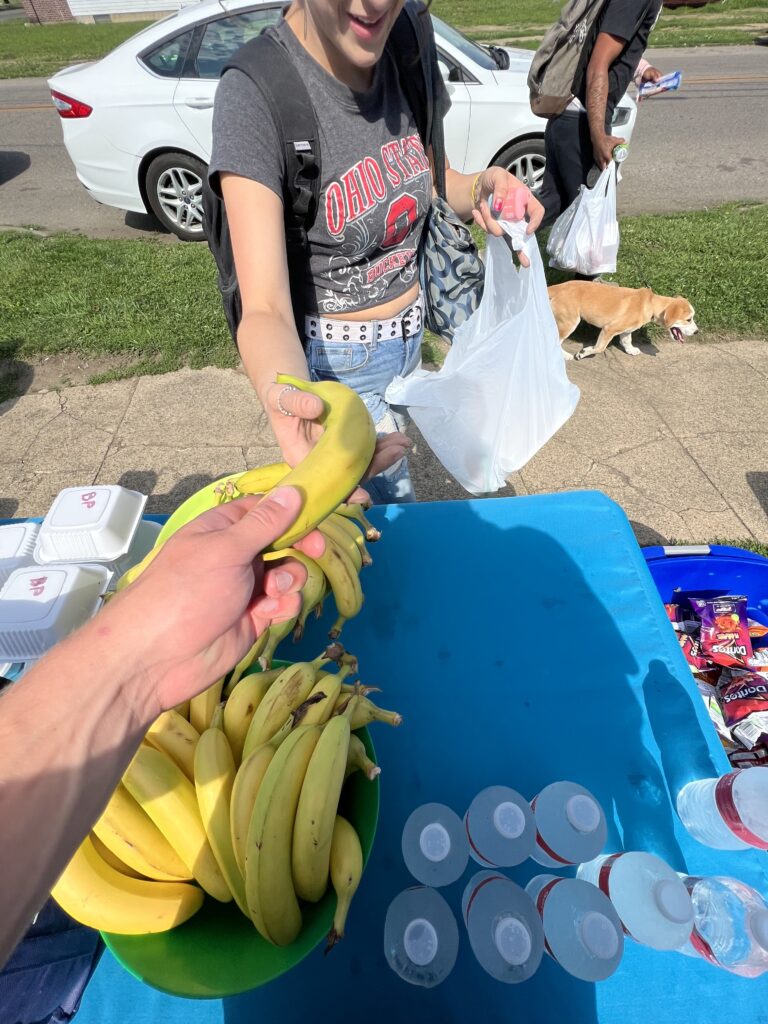
Volunteers are hard at work setting up tables that feature donated food, water, self-care items, hygiene kits, clothing and harm-reduction kits. At the first table, Brian Gregory grills his fan-favorite hot dogs while Anne Marie Thompson preps fresh baked ziti. The next table sports a variety of sides, fruit and desserts for guests to choose.
“What makes us unique is that we give our guests a choice, whether it’s between ziti or hot dogs,” said Outreach co-founder Patricia Perry, motioning to the main dishes, “Many of our guests are used to being told what they’ll be eating or where they’ll be living. We believe that the small bits of freedom we can bring have the potential to make someone’s day.”
On this morning, Perry is at the end of the line, consoling a guest dealing with a personal issue. The conversation ends with sincere thank-you from the guest and a warm hug from Perry.
Perry and Jen Kanagy started the outreach in 2018. Back then, it was nothing but a coat drive.
“At the time, people were posting all over Facebook that they had all these coats they wanted to give away, so I told Jen, ‘Let’s do a coat drive,’” Perry said.
The following weekend, on a cold, sleeting Saturday, the two hosted the coat donation event in downtown Newark. They did that a few more times before they realized the greater need.
“So many people were coming out to get coats for them, and, a lot of the time, for their children,” Perry said.
Before long, the two had merged with a couple who served food on Saturday mornings out of a food truck. The problem was, they served from only November through January. Perry and Kanagy stepped in to fill the gap. As time went on, they were serving up to 40 people each Saturday.
“It was all well and good ’til we were asked to leave by the owner of the lot,” Perry said. “We said, ‘Fine,’ and set up on the small public plot of grass next to it. We didn’t miss a beat.”
In late 2018, after a month of squeezing into the public plot, retired Newark Police Detective Denny McClain offered up a plot he owned at the corner of E. Main Street and Buena Vista Avenue for Perry, Kanagy and the Outreach team.
“It was just a grass plot back then. Wasn’t much, but for the first time, it was a place that was ours. … No one was going to force us out,” Perry said.
Despite the hurdles they faced, Perry and Kanagy served hot dogs and offered clothing to those in need.
Today, the Newark Homeless Outreach serves as a hub for the basic needs of those living on the streets. No matter the weather – rain, snow or shine – Outreach volunteers are there every Saturday morning to offer smiles and hugs along with nutritional, home-cooked meals, water, clothing, and harm reduction kits.
As guests lined up one Saturday in July, the mood was dark. A beloved member of the community had died the previous Monday, and word quickly made its way up and down the line of people.
“Little John,” originally from Seattle, lived in Newark for more than a decade and was a friend to many. He was found dead of a fentanyl overdose in his tent in an alley near the Salvation Army.
“I’ve known John for about 15 years; he was out here before me, long before me,” said one guest at the Outreach. “He was always there for each and every one of us. The sadness among us this week was unbearable.”
“John was a character; he always had a crazy story to tell,” Perry said. “This is why we have the harm-reduction kits. They’re designed to save lives, and most of the time they do.
“Unfortunately, no one was with John that night,” Perry said, handing out a business card featuring the message, “Never use alone,” and a phone number: 1-800-484-3731.
Harm-reduction kits are the staple of the Outreach, and that makes the Outreach services unique. The kits in brown lunch bags include new syringes, alcohol wipes, and most importantly, Narcan, which can quickly reverse an overdose.
She gets the Naloxone from Harm Reduction Ohio, which is based in Granville.
“We get a lot of push back from handing out these kits,” said volunteer Linda Mossholder, because some people think the kits encourage drug use. “But at the end of the day, someone’s life is more important than a used needle on the side of the road.”
The group’s goal in providing the kits, Perry said, is to keep people with substance use disorder alive so that they can work toward recovery. The contents of the kits protect those with substance use disorders by providing them with essential supplies and information to mitigate the potential dangers associated with drug use, she said.
“Whether people want to admit it or not, it’s saving lives,” said volunteer Nancy Welu. “Just last week, we saw multiple folks OD each day. You know what saved all of them? Narcan. We’d have a real problem if it wasn’t being provided to our guests.”
Harm Reduction Ohio is Ohio’s largest naloxone distributor. In 2022, it distributed 42,077 kits in total.
Perry said the resistance to harm reduction is just one example of the stigmatization and discrimination faced by people who have the disease of substance abuse disorder.
“Addiction is not a choice; it’s a terrible, uncontrollable disease,” she said. “It’s just the same as having diabetes or heart disease, only in this case, there’s limited treatment options, and the ones that do exist are rarely accessible to those who really need it.”
That’s the spirit of the Outreach, Welu said.
“We’re not hiding our services inside a building,” she said. “We’re out on the streets where everyone can see us, meeting unsheltered folks where they are.”
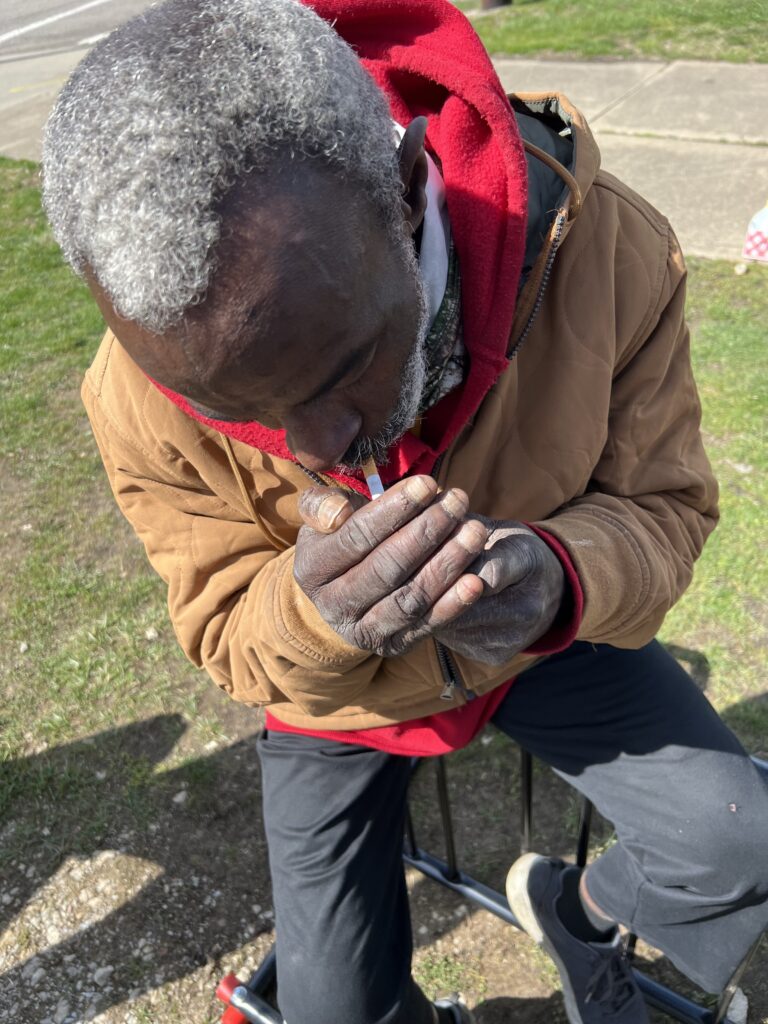
After receiving his food and selecting a new pair of shoes, an unsheltered man found shade under a towering mulberry tree behind the Outreach building. He relaxed by leaning on his backpack.
“There’s a reason so many of us show up here every Saturday, and it’s not for the bread pudding and hot dogs,” the man said. “It’s because it’s safe here. No one’s judging you or telling you what to do. … In a way, it’s like going over to your grandma’s for Sunday dinner. For an hour or two, you can just feel unbothered and at peace.”
Mossholder agreed.
“Our guests deserve to be treated with respect in a nonjudgmental environment,” she said. “The Outreach is so important to me because people need to know we care about them.”
While the Outreach provides solace for members of the unsheltered community for a few hours on Saturdays, it’s a crutch and not a cure, Perry said.
“We can be a part of the solution, but only to a certain extent,” she said. “The real work has to be done by those who hold the power. Unfortunately, we haven’t gotten to see much of that.”
Perry has been leading the charge in aiding those with substance-use disorder and creating awareness about homelessness for almost 13 years, and she is inspired to keep at it.
“A few things keep me motivated: First, my son and the stigmatization he’s faced,” said Perry, who’s son Billy has been fighting addiction for more than a decade. “I’m also motivated by the fact that I, myself, live in a situation where I could be sat on the streets any day. I also do this for Michelle Baker, my son’s girlfriend, who died of an overdose in 2014.”
Perry carries an attitude of hope – for community-wide empathy, for enlightened community leaders, for individuals who struggle daily with poverty and homelessness and addiction, and for humanity.
“There’s so many wrongs that need to be righted, and I hope that one day I will get to see the change,” she said.
Jack Wolf writes for TheReportingProject.org, the nonprofit news organization of the Denison University Journalism Program, which is sponsored in part by the Mellon Foundation.

